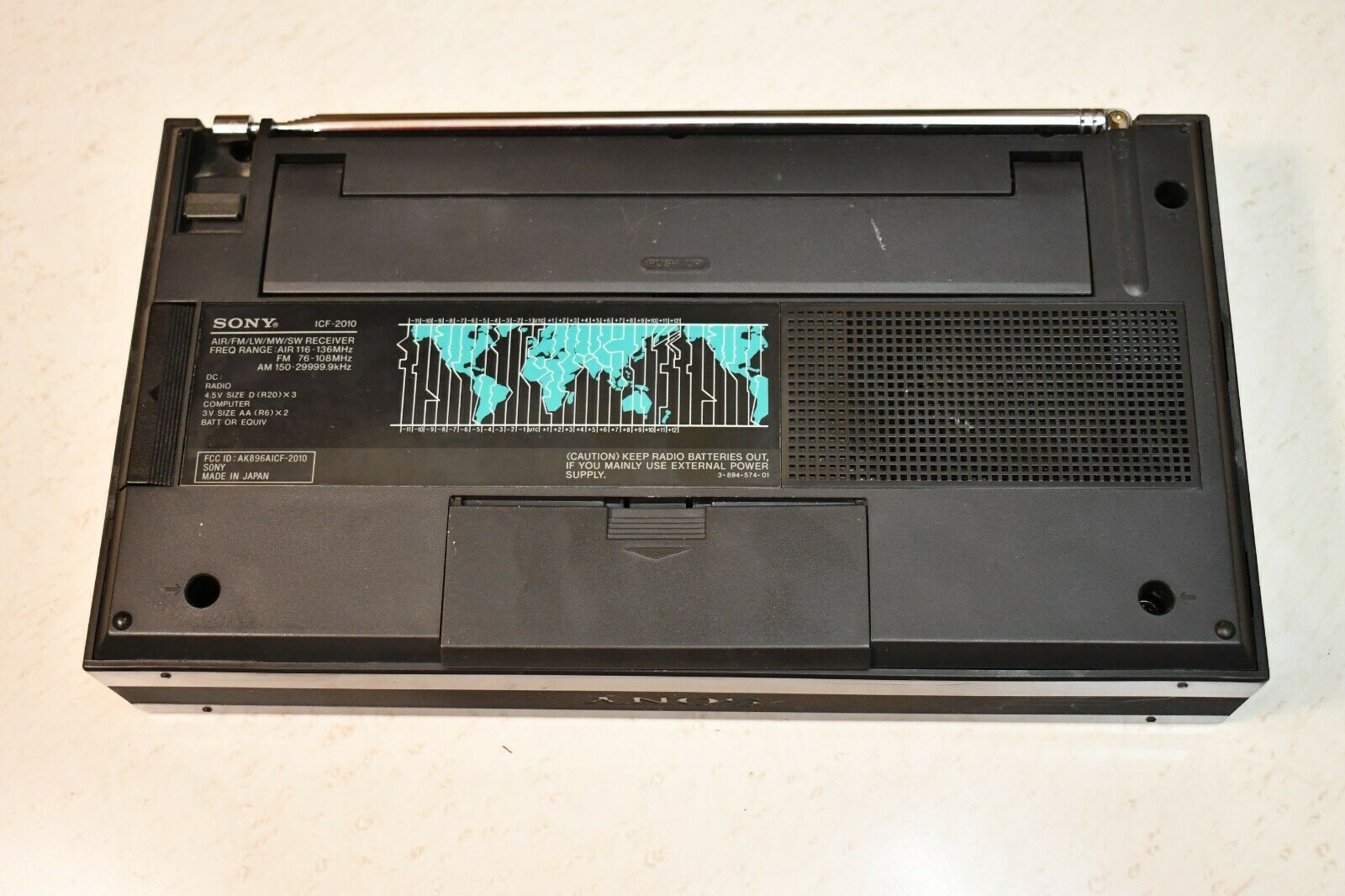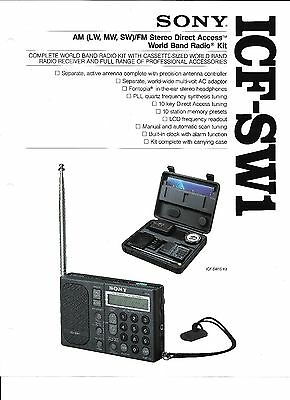-40%
Sony ICF-2010 Shortwave Radio AM FM SSB CW Receiver w/ 2-BOOKS!!! SUPER DEAL!!!
$ 158.4
- Description
- Size Guide
Description
Sony ICF-2010 Shortwave Radio AM FM SSB CW Receiver w/ 2-BOOKS!!! **CLASSIC**. Book #1 --Passport to World Band Radio. Book #2 Shortwave Listening Guidebook. Beautiful condition -- just look at the pictures!!!NOTE: The following listingdetails offers some background and historical information.
This Sony ICF-2010 beingoffered for sale has some minor signs of age and use. These 2010's oftenare well "loved" and typically show marks from age and use and thisradio is in very nice condition and is also not bad cosmetically. Pleaselook closely at our pictures for precise cosmetic condition. Serialnumber is 73711.
The telescopic antennaextends and retracts beautifully. We have tested all the featuresand found the 2010 to be operating within spec and showing no signs of failureor problems with any of the controls or functions other than the display lampis weak. This was a common issue as these 2010 radios age and the lightloses its intensity.
This ICF-2010 comes withmore documents than you are likely to ever see with any 2010 sale on Ebay. These documents add great value to the 2010 enthusiast. Included inthis sale are:
copy of the "Shortwave Listening Guidebook" The complete Guide to hearing the world. by Harry Helms.
copy of the " Passport to World Band Radio"
"TV Guide for world band radios." New York Times
To power the radio, youwill need a 4.5 volt AC adapter (included) or 3 D cell batteries (notincluded).
Here is some backgroundon the ICF-2010 radio.
The Sony 2010 radio wasmanufactured from 1984 until about 2001, but was available until about 2005 invarious markets. Thus, the 2010 held a remarkable record for nearly 20years of being an outstanding and highly desirable portable despite dozens ofnew portables being introduced in that same time period. The Sony isactually an outstanding example of an ideal consumer product that met a realneed and introduced a real leap forward in receiver technology. It wasthis sort of innovation that placed the last nail in the coffin of most of theAmerican radio manufacturing.
Over the years, theAmerican radio manufacturers like P*hilco, R*C*A, Z*enith, and scores of othersmanufactured outstanding products. Especially after WW2, the sky seemedto be the limit. However, while our national manufacturers began tocheapen their cabinets and offer an array of inexpensive products, Germany wasstill offering fine wooden cabinets with the resulting warm sound to it'scustomers.
Manufacturers likeG*rundig and T*elefunken produced world renown radios that are still heraldedtoday as some of the best radios from that era. Z*enith was in the midst ofit's long and successful line of Trans*Oceanic radios that were popular withthe public as well due to their sensitivity and portability.
During the 60's theZ*enith TO's 1000 and then the FM version called the 3000 were absolutedynamite with the public, though costly to purchase. The radios couldgather information from all parts of the world due to their world bandcapabilities and were extremely popular with the US troops deployed in Vietnamat the time. However, once the 70's arrived, the Trans*Oceanic line beganto look a bit dated as newer models of radios began to emerge from Japan takingadvantage of the latest transistor technologies. In the late 70's, the TOsales fell dramatically as the Japanese began to emerge as market leaders withdigital readouts in their P*anasonic and Sony units.
Then in 1980/81, Sonyintroduced the state-of-the-art ICF*2001 receiver that could direct dial any frequencyby virtue of it's keypad and lock in the signals using a more sophisticatedPhase Locked Loop by picking up on the famous Wadley Loop concept andfurthering this to the next generation of sophistication with superb stability. The result of all of this was that the last remaining vestige of theAmerican radio industry, and Z*enith in particular, ceased producing theirradios.
The Sony ICF*2001 was notwithout its drawbacks, however. It was known to consume batteries at arapid rate, did not offer the user a way to slew tune or band scan with it'spush buttons, and did not offer some of the same sensitivity as some of it'searlier predecessors. Personally, I was not discouraged by these factsand still own and regularly use my *2001 purchased as one of the first radiosoff of the shipping dock from Japan.
However, the SonyCorporation was listening to its consumers of the *2001 and went back to thedrawing board and came out with the ICF-2010 in late 1984. All of theissues that had surfaced with the *2001 were now resolved, but Sony did notstop there. They introduced the 2010 to much fanfare because it nowoffered features not typically found on portable radios such as multipletimers, multiple memories, keypad and dial tuning, unprecedented sensitivity,AND perhaps best of all, a new invention for consumer portable shortwave radiocalled Synchronous Detection. The sync detector was not only new for aportable in 1984, it was exceedingly good, sideband tuneable, and even near theend of the 2010's manufacturing cycle some 20 years later was considered one ofthe best ever offered in a radio.
In the end, it was notthe fact that a better radio came on the market to kill the production of the2010, but rather, it became unprofitable for Sony to continue manufacturing it. In the 20 years since manufacturing it had begun, the cost for labor andmaterials had risen and with the introduction of surface mount circuit boardtechnology, the price to pay electronics workers to solder and assemble was nowunreasonable. Sony had a variety of nice radios to offer, but had nodirect high-end portable receiver like the 2010 to offer to the public whenproduction ceased. Shortwave enthusiasts grieved the loss.
Today, for portablereceivers, the 2010 remains as a classy receiver in the market and thousands ofthem are still in use each day worldwide and can be purchased on the usedmarket in such places like on Ebay.
These 2010's are greatshortwave radios. Not only are they sensitive using the whip antenna, but theygive the user the ability to listen to longwave, AM, and FM radio. Inaddition, since they have a sideband detector designed in them, you can tuneinto amateur radio transmissions. The synchronous detector is absolutelyfantastic and allows the listener to use it on either upper or lowersideband. You merely tune the radio slightly off the direct frequency andcan select the portion of the wave that is less distorted from propagation orside channel interference. In my opinion, Sony created a classic piecewith this radio, and if it is not hampered by the bad FET, can even outperformthe vast majority of radios sold over the past 25 years.
Why shortwaveradio? In an era when one can tune into hundreds of satellite TV channelsor thousands of internet stations, shortwave still offers the listener theability to hear signals transmitted over a considerable distance. Thereis little advertising on shortwave and little filtering of content to satisfyadvertisers. The TV channels are selected based on your cable TVprovider's choice of programming and not all countries offer their programmingon the internet. Shortwave listening is a medium that offers unfetteredreception of signals. As a hobby, you learn when to listen, how tolisten, and what to do to improve listening. If you like "easy"listening, then you would listen to the major broadcasters. However,tuning into signals not destined for your area sometimes offers somesurprises. Over the years, we have learned a lot on shortwave that wewould never, ever, hear on the regular broadcast mediums. Since moststations do not require advertising, you understand that you will hear a widerrange of programs that may "offend" advertisers that use the TV orthe internet. Shortwave listening is definitely a hobby. There area lot of avenues to explore and avenues of interest. This Sony ICF-2010is an excellent unit to really experience the hobby.
Here are some reviews forthe ICF-2010 on eHam from other users...note that it is given a 4.7 out of 5.0by 70 reviewers...very high marks:
Please use the Ebayshipping calculator to determine your shipping cost. This cost includesproper packing materials for safe delivery and insurance cost against damage orloss.
Those buyers livingoutside the USA are also welcome to purchase from us. You may use theshipping calculator to determine your shipping cost.
Please keep in mind thatthis cost may not include any import, customs, or VAT fees. If you areuncertain of these costs, we ask you to check with your local post office priorto making a purchase from us. Thank you!
Thank you for taking thetime out of your busy day to look at our Ebay items!

















